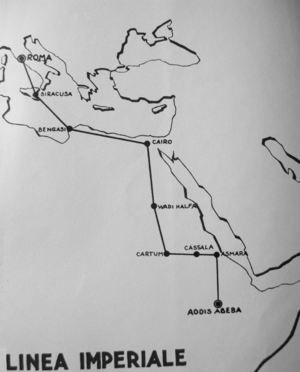Imperial Line facts for kids

The Imperial Line (Italian: Linea dell'Impero) was a very important flight route for Italy's national airline, Ala Littoria. It operated between 1935 and 1941, during a time when Italy was led by a government called the Fascist regime. This route was the longest and most famous flight path in Italy's colonial empire in Africa.
It connected Rome, the capital of Italy, with several cities in Africa. These cities included Benghazi in Libya, Asmara in Eritrea, Addis Abeba in Ethiopia, and Mogadishu in Somalia. The planes carried both passengers and mail. Italy eventually lost control of this route during World War II.
Some historians say that celebrating these air links showed how modern Italy wanted to be seen. It highlighted ideas like speed, progress, and reaching far places. It also showed a desire for technological power and control over nature and vast spaces.
Contents
How the Imperial Line Started
Ala Littoria's flights to East Africa began in 1935. It was first called Linea dell'Impero. In July 1935, Ala Littoria made an agreement with a British airline called Imperial Airways. This agreement helped passengers travel part of the way.
Imperial Airways would fly passengers from Brindisi in southern Italy to Khartoum in Sudan. This was part of their own route to South Africa. From Khartoum, Ala Littoria's planes would then take over. They would fly passengers to places like Kassala (Sudan), Asmara (Eritrea), and Mogadishu (Italian Somaliland).
Full passenger service from Rome to Mogadishu started in November 1935. By March 1937, more stops were added. These included Gorrahei in Ethiopia and Beledweyne in Somalia.
Flight Times and Schedule
The Imperial Line was not a very fast route. For example, flying from Rome to Massawa took three days. The head of Ala Littoria, Umberto Klinger, once said it took about three and a half days to fly from Rome to Mogadishu.
After Italy took control of Ethiopia, Addis Abeba was added to the route. However, there were delays in opening this part of the route. This was because Italy needed permission from the Egyptian government to fly over their country. The first few flights to Addis Abeba even flew without these permits.
By October 1937, there were four flights each week from Rome to Asmara and Addis Abeba. Asmara had two weekly flights to Djibouti and two more to Mogadishu. Flights usually left Rome at 10:15 a.m. However, arrival times were less exact. They were often just listed as dawn, morning, or afternoon.
Airports and Airplanes Used
Many airstrips in Italy's African colonies were in challenging locations. They were often "hot and high," meaning they were at high altitudes and in hot weather. This made flying more difficult and dangerous. The long distances between airstrips in East Africa also led to more accidents. About 40% of accidents on the Imperial Line resulted in deaths. This was higher than the 20% on European flights.
Besides planes that landed on solid ground, the Imperial Line also used seaplanes. These planes could land on water, which was useful for coastal routes or lakes and rivers. By 1938, a Cant Z.506 seaplane flew the direct route from Rome to Benghazi. The leg from Benghazi to Addis Abeba was flown by a Savoia-Marchetti S.73. Both of these were "trimotors," meaning they had three engines.
Most of the planes on the Imperial Line used engines made in other countries. However, one S.73 had an Italian Alfa Pegaso engine. Also, a Fokker F.VII trimotor used within East Africa had an Alfa D.2 engine.
Maintenance bases for the planes were located in Rome, Brindisi, Benghazi, and Asmara. These bases helped keep the aircraft in good working order.
Passengers and Money Earned
The Imperial Line's network in East Africa made the most money for Ala Littoria. In 1936–37, it earned about 44 million lire each year. It had the highest earnings from passengers, about 9 million lire. It also had the highest earnings from mail, about 35 million lire.
This route was unique because it earned more money from mail than from passengers. This was true even though it carried fewer passengers than other routes. Only about 5,000 passengers flew on the Imperial Line each year.
 In Spanish: Línea del Imperio para niños
In Spanish: Línea del Imperio para niños

